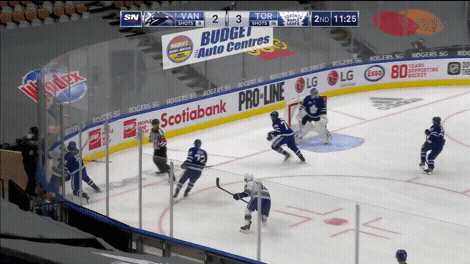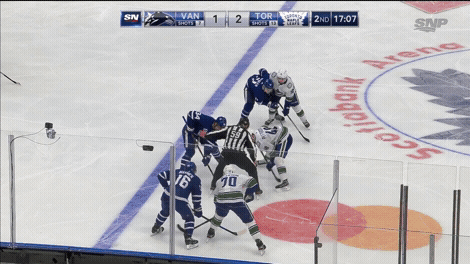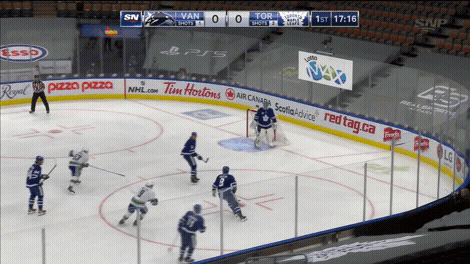When I was afforded the opportunity to join the coaching staff of the Toronto Marlies in 2015-16, I wasn’t exactly new to coaching theory. For one, I was attentive as a player in both college and pro, but I also grew up with a Dad who played in the NHL then went on to coach a number of years in the minors. I had discussions about strategy and was in the offices to hear how decisions get made.
What I saw with the Marlies, though, wasn’t what I had seen from my Dad’s teams in late '90s, or heard from my own coaches when I played. Stats were obviously a bigger thing, but there were new tactical concepts to be introduced to, many passed down from Mike Babcock to the Leafs AHL franchise, and many preferred by Sheldon Keefe himself.
Perhaps the most useful new idea in my estimation, at least when it came to defending, was the Babcock-termed strategy of “cut-offs,” which in plain English is running interference on opposing players who aren’t directly involved around the puck as they skate back towards your end.
Constantly.
Think of a team leaving their D-zone on a breakout and up through the neutral zone. If you’re the last guy back for your team (that doesn’t have the puck), you might as well step in front of the last guy up the ice on the opposing team and slow his ability to join the play on offence. It cancels second and third wave attacks, it widens the gap between their forwards and D (which makes breakouts easier), it slows them down, it tires them out. It’s just a lot of good for a little rat-like effort.
Basically you’re testing a ref: if you’re gonna call a small crosscheck (the part of the cut-off Babs calls a “sting”) 100 feet from the puck you’re gonna have to put 100 guys in the box every night. (Hey, it’s not the job of coaches to preserve the quality of gameplay.)
It’s with the introduction to that term we swing back around to the Canucks and the Leafs, and note that if the Canucks don’t start cutting the Leafs off out of their own zone -- if they don’t employ some stings -- their defence is going to get eaten alive again Saturday night. It’s not so much that the Leafs themselves are unmanageable on the rush, it’s that any team is unmanageable if they’re allowed to fly up the ice with speed, and the Canucks' D simply isn't good enough to bear that burden alone. Defencemen often take the public lashings caused by half-committed forwards who allow the opposition to fly up the rink unimpeded.
To drive this point home, here’s how Keefe responded to a question about whether he saw more offensive pace from his group:
“I did. It was the best we looked in that regard just in terms of how we left our zone, how we got through the neutral zone, how quickly we moved the puck — all of those types of things. I thought it was really good for all four lines.
Our defence, even after going down to five D pretty much the whole game, I thought those guys did a really good job of moving the puck up very quickly to the forwards and getting involved in the offence themselves.”
I’m writing this from a Vancouver standpoint because this is an obvious strength for the Leafs, which means it should be a focus for the Canucks. Inattention there allowed Toronto’s skill to build momentum into the neutral zone, resulting in the Leafs out-chancing the Canucks 29-14, with an advantage in high-danger chances of 13-5.
I’ll just use the plays that resulted in goals as an example, given the direct cause-and-effect relationship, but cut-offs are important whether missing them leads to a chance against or not.
On the Leafs' fourth goal Thursday night, they’re left to fly out of their own zone, in large part due to the huge gap between the Canucks forwards and defenders. But if Adam Gaudette in the middle of the ice even gets above one Leafs player (ideally the man in the middle, Travis Boyd) the whole things slows down and develops differently, likely denying a goal before it has a chance to play out.
It’s Boyd’s speed through the middle that pushes the Canucks D back and leaves the gap for Nic Petan to sauce one over to Jason Spezza.

On the Leafs' third goal, they win a neutral zone faceoff and regroup, which means the Canucks are starting from assigned defensive positions. The Canucks use what looks like a 2-1-2 with pressure from the wings off a lost neutral zone draw, and Elias Pettersson drops back to stay above the middle guy.
Only, he doesn’t stay above the Leafs winger (a simple sting would’ve killed Marner’s momentum), who gets in behind him by a step, gets to the puck first, and makes a great play. But there’s no reason Marner shouldn’t have been cut-off, leaving Pettersson to the first touch on this chipped puck.

A less obvious one was early on Matthews' first goal, where he was allowed to wheel behind the net and get his speed up before getting fortunate with how the play developed. JT Miller was covering back for his pinching defender; after the game he mentioned that because of that, he thought he’d be playing left D, with support on his right (he readily took the blame, but was just explaining his thinking). It wasn’t until too late he realized he was 1-on-1 defending Matthews.
That aside, Brock Boeser has the chance to go “oh-uh, this might not be an offensive situation anymore” deep in the Leafs territory, and step in front of Matthews as he winds up what looks like a dangerous break out early.
Watch right as Matthews cuts and jumps up from behind the net, you can see Boeser watching and hoping the play kicks back deep into the zone so he can play on the offensive side of things. He lets Matthews jump by him and get his speed up.

He’s not solely to blame of course, but he could’ve taken a step into Matthews' lane to slow the freight train down. If Matthews is a half-stride slower I like Miller’s odds of influencing a worse shot attempt, and it’s a game of inches.
That’s all any of this comes down to. You don’t know when you’re positively impacting the play with a cut-off, which means you don’t get much praise for each individual effort. (Your coaches can’t watch everyone at once, and it’s behind the play, so not doing it often goes unpunished.) But it’s a little thing good teams do consistently that makes them so difficult to play against. It can be a slog against a fully bought-in team who slows you down all over the ice, like the best Boston Bruins teams have over the past decade.
The numbers in blue on the right show the bottom five in the NHL in goal-against-per-game. That’s the Canucks there, in 30th.

This Canucks D may not be the greatest, but I certainly don’t think they’re that bad. Their forwards have to help them out.
Even offensive juggernauts can be contained with good defensive commitment from every position. If the Canucks want better results on Saturday, they can start by asking the forwards to better defend out of the offensive zone.
